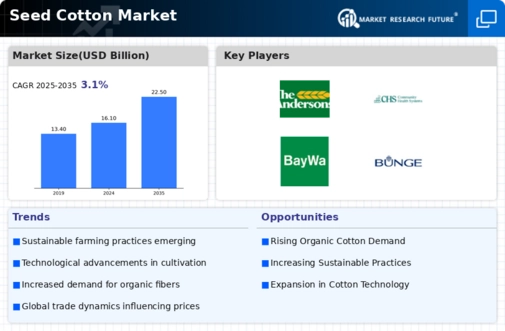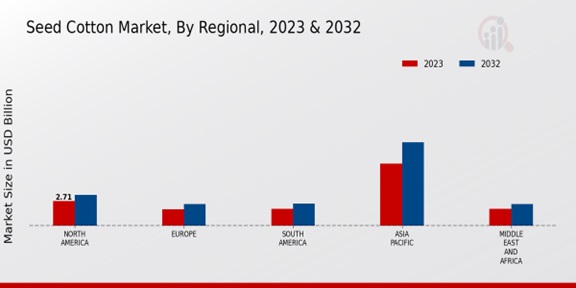Government Support and Subsidies
Government policies and subsidies play a crucial role in shaping the Global Seed Cotton Market Industry. Many countries provide financial support to cotton farmers to stabilize prices and encourage production. For example, the United States Department of Agriculture offers various programs aimed at supporting cotton growers, which helps maintain a steady supply in the market. Such initiatives are essential in mitigating the risks associated with cotton farming, thereby fostering a conducive environment for growth. As a result, the Global Seed Cotton Market Industry is expected to thrive under favorable government policies that promote cotton production.
Market Trends and Growth Projections
The Global Seed Cotton Market Industry is poised for growth, with projections indicating a market size of 16.1 USD Billion in 2024 and an anticipated increase to 22.5 USD Billion by 2035. This growth trajectory suggests a compound annual growth rate (CAGR) of 3.09% from 2025 to 2035. Key trends driving this expansion include rising consumer demand for cotton products, advancements in agricultural technology, and increasing sustainability efforts. As these trends continue to evolve, they will shape the future landscape of the Global Seed Cotton Market Industry, presenting opportunities for stakeholders to capitalize on emerging market dynamics.
Market Dynamics and Price Fluctuations
Market dynamics, including price fluctuations, significantly impact the Global Seed Cotton Market Industry. Prices are influenced by various factors such as weather conditions, global supply chain disruptions, and changes in demand. For instance, adverse weather events can lead to reduced yields, causing prices to spike. Conversely, an oversupply can lead to price drops, affecting farmers' profitability. Understanding these dynamics is essential for stakeholders in the Global Seed Cotton Market Industry to navigate the complexities of cotton pricing. The projected CAGR of 3.09% from 2025 to 2035 indicates a need for strategic planning to adapt to these market fluctuations.
Rising Global Demand for Cotton Products
The increasing global demand for cotton products is a primary driver of the Global Seed Cotton Market Industry. As consumer preferences shift towards natural fibers, the demand for cotton textiles, apparel, and home furnishings continues to rise. In 2024, the market is projected to reach 16.1 USD Billion, reflecting a growing inclination towards sustainable and eco-friendly materials. This trend is particularly evident in emerging economies where disposable incomes are rising, leading to higher consumption of cotton-based products. The Global Seed Cotton Market Industry is thus positioned to benefit from this upward trajectory in demand.
Sustainability Initiatives in Cotton Production
Sustainability initiatives are increasingly becoming a focal point within the Global Seed Cotton Market Industry. With growing awareness of environmental issues, stakeholders are adopting practices that minimize ecological footprints. This includes organic cotton farming, which has seen a surge in popularity, as consumers seek products that align with their values. The market for organic cotton is projected to expand, contributing to the overall growth of the Global Seed Cotton Market Industry. By 2035, the market is expected to reach 22.5 USD Billion, driven by these sustainability trends that resonate with environmentally conscious consumers.
Technological Advancements in Cotton Cultivation
Technological innovations in cotton cultivation are significantly influencing the Global Seed Cotton Market Industry. The adoption of precision agriculture techniques, genetically modified seeds, and advanced irrigation systems enhances yield and reduces resource consumption. For instance, the use of biotech seeds has been shown to increase cotton yields by up to 30 percent in some regions. These advancements not only improve productivity but also contribute to sustainable farming practices. As farmers increasingly embrace these technologies, the Global Seed Cotton Market Industry is likely to experience growth driven by enhanced efficiency and reduced environmental impact.
















Leave a Comment